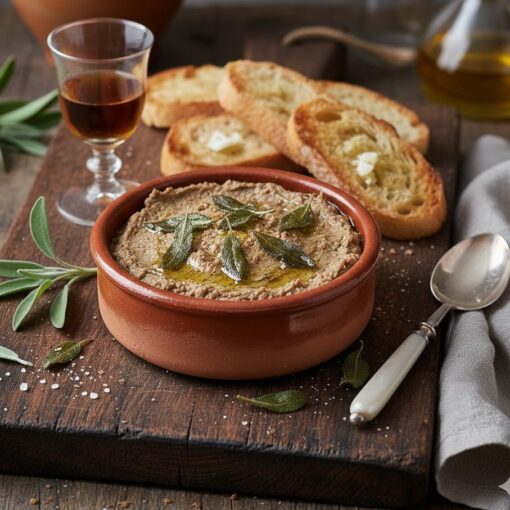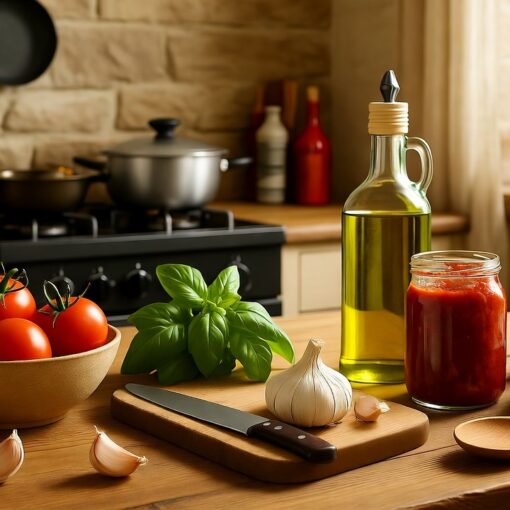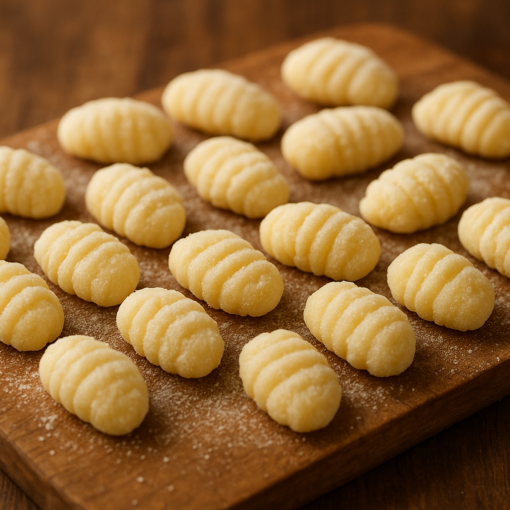Tagliatelle
Farfalle
Orecchiette
Fusilli
Ravioli
Tortellini
A Collection of 6 Homemade Pasta Recipes
Fresh Italian pasta shapes — each with history, flavor, and perfect sauce pairings
Homemade pasta originated in Italy centuries ago. These six classic shapes showcase its versatility using simple dough ingredients like flour and eggs. Includes two filled pastas with sample fillings, plus a short origin story, a fun fact, and sauce recommendations. All recipes use the same basic dough for consistency.

Six fresh masterpieces — homemade pasta for every occasion and sauce.
Prep Time30 min
Rest Time30 min
Total TimeVaries
Servings4
Tips and Hints for Making Homemade Pasta
- Use 00 flour for the best silky texture; all-purpose works but results in chewier pasta.
- Knead the dough for 10-15 minutes until smooth and elastic to develop gluten.
- Rest the dough wrapped in plastic for at least 30 minutes to relax the gluten and make rolling easier.
- Keep the dough covered to prevent drying out; dust with flour as needed to avoid sticking.
- Roll the dough as thinly as possible for tender pasta; aim for translucent sheets.
- Use fresh eggs at room temperature for better incorporation into the dough.
- Boil in salted water and taste for doneness: fresh pasta cooks in 1-3 minutes.
Tagliatelle
Origin: Emilia-Romagna, Italy, 15th century. Long, flat ribbons traditionally served with ragù.
Fun Fact: The Accademia Italiana della Cucina registered the official width of tagliatelle as 8mm in 1972!
Ingredients
- 400 g 00 flour
- 4 large eggs
- Pinch of salt
Method
1. Make the dough: Pile flour on a clean surface. Form a wide well in the center. Crack eggs into the well and add salt. Beat eggs with a fork, gradually pulling in flour from the edges until a shaggy mass forms. Use your hands to knead, adding water (1 tsp at a time) if dry or flour if sticky.
2. Knead thoroughly: Knead 10–15 min by pushing with the heel of your hand, folding, and turning. The dough is ready when it’s smooth, elastic, and springs back when poked. Wrap tightly in plastic and rest 30 min at room temperature.
3. Roll the dough: Divide into 4 pieces. Work one at a time (keep others covered). Flatten into a rectangle. Roll with a pin or pasta machine from thickest to thinnest setting until 1–2 mm thick and nearly translucent. Dust with flour as needed.
4. Shape tagliatelle: Lay the sheet flat. Fold loosely accordion-style into a 5–7 cm wide roll (loose folds prevent sticking). With a sharp knife, cut straight across into 8 mm strips. Unfold each ribbon gently, shake off excess flour, and form into loose nests on a floured tray. Let dry 10–15 min.
5. Cook: Boil in generously salted water 2–3 min until al dente. Drain, reserving ½ cup pasta water.
Recommended Sauce: Carbonara — creamy, smoky, and clings perfectly to flat ribbons.
Carbonara Sauce
- 200 g guanciale or pancetta, diced
- 4 egg yolks
- 100 g Pecorino Romano, finely grated
- Freshly ground black pepper
1. Crisp guanciale in a large skillet over medium heat, 5–7 min. Reserve fat.
2. Whisk yolks, cheese, and generous pepper in a bowl.
3. Off heat, toss hot pasta in the skillet with fat. Stir in egg mixture quickly, adding pasta water to create a glossy sauce.
4. Mix in guanciale. Serve immediately.
Pro Tip: A pasta machine ensures perfectly even thickness.
Photo credit: Emilia-Romagna tradition
Farfalle
Origin: Lombardy & Emilia-Romagna, 16th century. Bow-tie shape inspired by butterflies.
Fun Fact: “Farfalle” means “butterflies” in Italian — perfect for spring dishes!
Ingredients
- 400 g 00 flour
- 4 large eggs
- Pinch of salt
Method
1. Dough & rest: Same as tagliatelle — knead, rest 30 min.
2. Roll thin: Roll to 1–2 mm thick sheets.
3. Cut rectangles: Use a knife or fluted pastry wheel to cut 5 cm × 3 cm rectangles. Cover cut pieces with a damp cloth.
4. Shape farfalle: Hold a rectangle horizontally. Pinch the center firmly between thumb and forefinger, pressing hard to fuse the dough and create pleated “wings.” If it won’t stick, dab the center with water. Fan out the ends slightly. Place on a floured tray. Dry 10–15 min.
5. Cook: Boil 2–3 min until they float and are al dente.
Recommended Sauce: Pesto — vibrant basil clings to every pleat.
Pesto Genovese
- 50 g fresh basil leaves
- 50 g pine nuts, toasted
- 50 g Parmigiano-Reggiano, grated
- 2 garlic cloves
- 100 ml extra-virgin olive oil
- Salt
1. Pulse basil, nuts, cheese, and garlic in a processor to a coarse paste.
2. Stream in oil until smooth. Season with salt.
3. Toss with hot farfalle and a splash of pasta water.
Pro Tip: A fluted wheel gives decorative ruffled edges.
Photo credit: Butterfly inspiration
Orecchiette
Origin: Puglia, Italy, 12th–13th century. “Little ears” traditionally made with semolina.
Fun Fact: Nonnas in Bari still shape them on wooden boards in the street!
Ingredients
- 400 g 00 flour
- 4 large eggs
- Pinch of salt
Method
1. Dough & rest: Same as above.
2. Form ropes: Roll rested dough into 1 cm thick ropes. Cut into 1 cm cubes.
3. Shape orecchiette: On a wooden board, press a cube under the flat side of a butter knife. Drag firmly toward you to flatten and curl the dough into a thin disk with ridges. Flip the disk inside-out over your thumb to form a dome with the rough side out. The center should be thinner than the rim to hold sauce. Place on a floured tray.
4. Dry 10–20 min. Cook 3–4 min until tender.
Recommended Sauce: Cacio e Pepe — the rough texture grabs every bit of cheese.
Cacio e Pepe
- 200 g Pecorino Romano, finely grated
- Freshly ground black pepper, toasted
- Pasta water
1. Mix cheese and pepper in a warm bowl.
2. Add hot pasta water gradually, whisking to a creamy paste.
3. Toss in hot orecchiette. Add more water if needed.
Pro Tip: A serrated butter knife gives authentic texture.
Photo credit: Puglian streets
Fusilli
Origin: Southern Italy. Hand-twisted spirals that grip chunky sauces.
Fun Fact: “Fusilli” comes from “fuso” (spindle) — traditionally wrapped around a knitting needle.
Ingredients
- 400 g 00 flour
- 4 large eggs
- Pinch of salt
Method
1. Dough & rest: Same as before.
2. Cut strips: Roll dough into 0.5 cm thick ropes. Cut into 6 cm pieces.
3. Shape fusilli: Dust a thin rod (knitting needle, skewer). Press one end of a strip onto the rod at a 45° angle. Roll the rod forward with both palms, applying even pressure to wrap the dough in a tight spiral (3–4 coils). Slide off gently. Place on floured tray.
4. Dry 10–15 min. Cook 2–3 min.
Recommended Sauce: Arrabbiata — spicy tomato chunks cling to every twist.
Arrabbiata
- 400 g canned San Marzano tomatoes
- 2 garlic cloves, sliced
- 1–2 tsp red chili flakes
- Olive oil, salt
1. Sauté garlic and chili in oil until fragrant.
2. Crush tomatoes by hand; add and simmer 15 min.
3. Season. Toss with fusilli.
Pro Tip: A clean knitting needle gives uniform spirals.
Photo credit: Southern Italian tradition
Ravioli
Origin: Liguria & Lombardy, 14th century. Stuffed pasta parcels.
Fun Fact: Mentioned in 14th-century manuscripts as “wrapped in dough”!
Ingredients
- Dough: 400 g 00 flour, 4 eggs, pinch salt
- Filling: 250 g ricotta, 50 g Parmesan, 100 g cooked spinach (squeezed dry), salt, pepper
Method
1. Dough & filling: Rest dough. Mix filling until smooth; chill.
2. Roll sheets: Roll two matching 1 mm thick rectangles.
3. Fill: Pipe or spoon 1 tsp filling in a grid, 4–5 cm apart. Brush water around each mound.
4. Shape ravioli: Lay top sheet over. Press around each mound to expel air and seal. Cut into squares with a wheel or knife. Crimp edges with a fork. Place on floured tray.
5. Cook 3–4 min.
Recommended Sauce: Sage Butter — nutty, fragrant, and delicate.
Sage Butter
- 100 g unsalted butter
- 10 fresh sage leaves
- 50 g Parmesan, shaved
1. Melt butter; add sage. Cook until butter browns and sage crisps.
2. Toss ravioli in sauce. Top with Parmesan.
Pro Tip: Remove all air to prevent bursting.
Photo credit: Stuffed pasta legacy
Tortellini
Origin: Bologna, 16th century. Tiny filled rings, often served in broth.
Fun Fact: Legend: shaped after Venus’s navel by a love-struck innkeeper!
Ingredients
- Dough: 400 g 00 flour, 4 eggs, pinch salt
- Filling: 200 g ricotta, 50 g Parmesan, 50 g prosciutto (finely chopped), pinch nutmeg
Method
1. Dough & filling: Rest dough. Mix filling with nutmeg.
2. Cut squares: Roll 1 mm thin. Cut 5–6 cm squares.
3. Fill: ½ tsp filling in center. Brush edges with water.
4. Shape tortellini: Fold into a triangle, seal edges, expel air. Wrap bottom corners around your finger, overlap and pinch. Bend top point down. Slide off. Place on floured tray.
5. Cook 3–4 min.
Recommended Sauce: Alfredo — rich cream blankets each ring.
Alfredo
- 200 ml heavy cream
- 100 g butter
- 150 g Parmesan, grated
- Black pepper
1. Melt butter in cream over low heat.
2. Whisk in cheese until smooth.
3. Season. Toss with tortellini.
Pro Tip: Use minimal filling for clean shaping.
Photo credit: Bolognese myth




